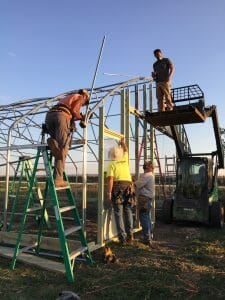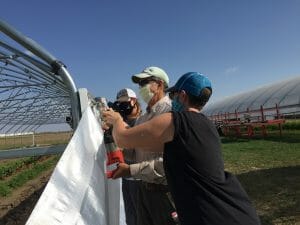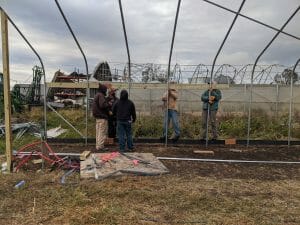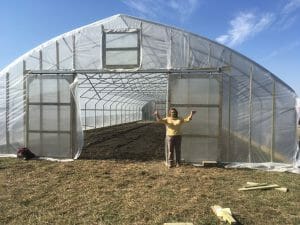Building Community and High Tunnels After the Derecho
When the powerful straight-line windstorm known as a derecho tore across Iowa in August, wreaking havoc on trees, power lines, crops and buildings, high tunnels were among the many farm structures damaged or destroyed. These buildings help extend the growing season, and for farmers raising specialty crops – like vegetables, flowers, garden plants and more – losing them was a big blow to their farm operations.
In the storm’s wake, the PFI community rallied to help members who lost these critical farm structures. During the weekend of Oct. 9-12, PFI hosted high tunnel builds at Donna Warhover’s Morning Glory Farm near Mount Vernon, Laura Krouse’s Abbe Hills Farm near Mount Vernon, and Eric and Ann Franzenburg’s Pheasant Run Farm near Van Horne. With positive attitudes, area farmers came out to help rebuild the high tunnels while learning about their construction – and fostering important connections in the process.
The builds were led by Adam Montri, a PFI member and high tunnel expert from Bath, Michigan, who also operates Ten Hens Farm. Because of the pandemic, extra precautions were taken: Groups were limited to a maximum of nine participants, and everyone wore face masks. The smaller crew and shorter timeframe meant none of the high tunnels was finished. Still, the familiar sense of barn-raising that comes with a PFI high tunnel build lingered as the hoops were hoisted. Work began each day at 9 a.m. To help maintain social distancing, crews split tasks and ate a catered lunch at a distance – but there was still plenty of opportunity to ask questions about high tunnels and discuss each other’s growing seasons.
“It felt different in that it wasn’t just one place with a lot of hands moving along. But things went incredibly smoothly, given everything.” – Adam Montri

T.D. Holub (left), Adam Montri (on the skidloader) and Jason Grimm (driving the skidloader) secure the channel lock that will hold the plastic cover in place on Laura Krouse’s high tunnel. On the ground, Marty Roth and Roger Schrock install a storm door salvaged from the old tunnel.
High Tunnels as a PFI Tradition
High tunnels, closely related to greenhouses, are covered structures that protect fruit and vegetable crops from rain and extreme heat. They can range from small “caterpillar tunnels” that fit in the backyard of a house, to 30-by-96-foot structures; and they can be stationary or moveable. High tunnels can significantly extend growing seasons, improve quality and allow farmers to grow a wider range of horticultural crops.
That extra growing time is critical for Donna. “High tunnels have really allowed me to increase the length of my growing season,” she says. “We start in February, harvest in April for commercial accounts, then my CSA begins the first of May. During April and May, I am only harvesting from the high tunnels. From a financial standpoint, [having them] has really made farming so much more sustainable.” Laura also attests to the financial benefits, estimating that crops from her two high tunnels represent half of her income.

Kristine Lang and Bonnie Riggan hold steady while Bill Warhover trims a metal sidewall component at Morning Glory Farm.
Building a high tunnel, however, takes time and many hands. Knowing they can substantially improve farm resilience, PFI has hosted five builds over the last decade: in 2009 at Abbe Hills Farm, 2010 at Genuine Faux Farm, 2012 at TableTop Farm, 2015 at Prairie Sky Farm and 2017 at Deal’s Orchard. Adam led four of these, and at each, one tunnel was built to completion. Because of the necessary safety restrictions this year, he says the builds had a slightly different vibe. “It felt different in that it wasn’t just one place with a lot of hands moving along,” Adam says. “But things went incredibly smoothly, given everything.”
After a rough year, the smoothness of the builds was a relief. The pandemic forced many farmers to rethink how to sell their items, since farmers markets and CSAs had to operate safer or less frequently. Then, just when tomatoes, peppers and eggplants were coming into peak production, and fall crops like broccoli and cauliflower were strengthening their stalks, the derecho hit.
Building Back From a Devastating Derecho
The storm started in Nebraska and gained strength as it moved across Iowa on its 700-mile trek. By the time it reached eastern Iowa, peak winds in some places hit 140 mph – a new state record for a non-tornadic wind gust. The ferocity rivaled a Category 4 hurricane. Unlike tornados, however, derechos produce long-lasting straight-line winds, which can be devastating for high tunnels, with their lightweight covering, as well as structures like silos – not to mention crops, livestock, trees, power lines and more.
Beyond damage to high tunnels, horticulture farmers emerged from the storm to find flattened crops, shredded crop leaves, fruit knocked from plants and snapped stalks. The high winds ripped Donna’s high tunnel from the ground, sending it flying into her neighbor’s soybean field. Laura’s tunnels were taken out alongside trees, crops and soil. The Franzenburgs, who built their high tunnels to focus on flower production, lost the tunnels, greenhouses, buildings and acres of flowers and crops. After assessing the damage, they and other farmers spent the next few weeks picking up and hauling storm debris, disassembling tangled steel, triaging salvageable crops and assessing their capacity to meet production commitments for the rest of the season.

The build crew at Pheasant Run Farm checks the level of the hip board. From left to right: Phil Ricks, Patrick Rose, Max Friton, Jeff Sindelar and Eric Jensen
With horticulture farmers facing such extensive damage, PFI’s horticulture program manager at the time, Liz Kolbe – who now serves as PFI’s education and engagement director – reached out to Adam about leading high tunnel builds at a few hard-hit Iowa farms. Ultimately, they came up with an intense weekend for an intense storm: building three high tunnels in four days.
Building Community While Gaining Skills
The build timelines were ambitious. Typically, a workshop will build one tunnel over three days with 15 attendees, and a little extra work from Adam and the hosts. Because of the extensive damage, Adam and Liz schemed a format to run three builds over two workshop days on each farm, with nine people at each. Talking with the farmers, they knew that even if the high tunnels were not completely finished, the builds could give each farm a huge boost on their re-building efforts.
While Liz coordinated logistics, scheduling and safety with Adam and the host farms, Carmen Black of Local Harvest CSA helped recruit volunteers for the builds within the Iowa City community. “Although I didn’t talk to her directly, Carmen was definitely the power behind the build,” says Ilsa Dewald, of Radical Patch Cooperative Farm in Iowa City, who attended Donna Warhover’s build. “She really motivated me, helping me realize ‘yes, I’m going to commit to [the build], reschedule my CSA harvest, take the weekend and do that.’”
“I don’t think other people realize how magnificent it is. It’s a lot more than just getting the high tunnel back up. I’m overwhelmingly satisfied [with the build] and couldn’t have asked for a better group.” – Laura Krouse
Before the builds got underway, the host farms had done as much site preparation as possible – leveling the site, squaring corners and pounding in most of the ground posts. They had also gathered a range of tools, most importantly 10- to 15-foot A-frame ladders, a bucket or skidloader and as many impact drivers as they could borrow or buy. Once all the ground posts were in, attendees worked atop ladders and along the sidewalls to assemble, place, align and secure steel bows, purlins and bracing, and footboards and hip boards along the sidewalls.
Because Adam couldn’t be in three places at once, each farm had a designated foreperson to lead the build while Adam was off-site. Bill Warhover and Eric Franzenburg served as forepersons at their home farms, while T.D. Holub, of Garden Oasis Farm near Coggon, served as foreperson at Abbe Hills Farm. Adam’s expertise, gained from building hundreds of high tunnels, helped each build run smoothly. Moving from site to site and communicating via text, he catalyzed each build’s progress by demonstrating techniques, setting up stations, powering through the hardest jobs and contributing to complex design decisions.

Laura Krouse stands by her completed high tunnel, which volunteer helpers from her CSA, Sundog Farm, Wild Woods Farm, Trowel and Error Farm and Rainbow Roots Farm helped her finish in early November.
Attendees expressed multiple reasons for volunteering to help with such physically taxing work: wanting to help rebuild after the storm, gathering with other farmers during a tough year and a desire to learn about high tunnel construction. Carly McAndrews and Bryant Mann, of Trowel and Error farm in Iowa City, knew Laura Krouse and wanted to help her rebuild. But they were also curious about the process of building a tunnel in case they wanted one. After learning more about high tunnels at the build, they realized how a high tunnel would benefit them. “We’re always looking for opportunities to learn more and get hands-on construction experience,” Carly says. “I didn’t expect how inspired I would be to really want a high tunnel one day.”
Patrick Rose, who operates Rose Farm near Norwalk, attended the Franzenburg build but visited the other farms to compare high tunnel manufacturers and designs. He says he felt especially grateful for Adam’s guidance, and for the conversations with other attendees. Ilsa Dewald attended out of curiosity to learn about high tunnel construction, especially given the three builds happening simultaneously. Her friend and farming partner, Joe Klingelhutz, attended Laura’s build and Ilsa attended Donna’s build so they could compare designs, methods and high tunnel manufacturers. “It was interesting to see how differently [the builds] went, because the farms were not building the same tunnel,” Joe says. “Also, skill-building was important, wanting to get better specifically at high tunnel building, and it was nice to use more power tools.”
“Getting to hear people’s stories, taking time to just laugh and visit, is something I’ve missed this season, since everything has been so distanced and safe for our shareholders and community in general.” – Donna Warhover
A favorite part of any PFI event is the opportunity to commune and connect with other farmers. During a summer when every PFI field day was hosted online, being together felt especially poignant. Donna says, “Getting to hear peoples’ stories, taking time to just laugh and visit, is something I’ve missed this season, since everything has been so distanced and safe for our shareholders and community in general.” The sense of community extended across builds too: If a farm was short on steel bands, frame pieces or a bag of screws, the other farms sent over their extras. For the farm hosts, the community support offered a hopeful counterpoint to the stresses of the past several months. “Due to the extensive damage we had, it was nice to put something up and see something new,” Eric says. “We’d been in the tear-down phase for a couple of months, and it was a really good mental change [to see] that things at some point in time are going to get better.”
Beyond the immeasurable value of rallying as a community and strengthening those bonds, the builds offered valuable knowledge about the tools, tasks, and importantly, the logistics of building a high tunnel. The skills and knowledge gained will help participants on their own farms, and also better position them to help farming friends during future builds.
Optimism and Inspiration for the Future
Carly found inspiration from the high tunnel build, and wants to expand from her caterpillar tunnel to a high tunnel. However, she and Bryant will wait until they find a more permanent location for their farm to make the investment. Patrick is pleased he attended, and with his newfound experience plans to build two high tunnels, with help from friends and others, as soon as he gets his flowers out of the ground. He has pieces of the high tunnel kits on hand, and is waiting on other pieces to arrive soon. “I would encourage people to volunteer for these builds,” he says. “Not only do you get to help someone in need, you gain experience and you gain new friends or a network of people doing the same things you’re doing.”
For Donna, it’s difficult to determine the future, given the year has required one adjustment after another. But she is optimistic that the renewed appreciation for community and local farms, especially in the wake of COVID-19, will continue. “For my shareholders, it’s been a great year, being able to obtain locally grown, healthy food in a very easy, minimal-contact way during such a stressful and crazy year,” she says. “I’m hopeful for next year that people will continue to support local growers.”
With so much destruction on their farm, where winds may have reached 140 mph, Eric and Ann will continue the work of rebuilding. “This is the first step in getting the farm back on track,” Eric says of the high tunnel build. “It gives you momentum going into the rest of the fall and winter.” After making significant progress on the high tunnel, he feels the farm is headed in the right direction. He’s even made specific plans for what the new tunnel will hold: “Most of it will house flowers or vegetables, but I’m going to play around with putting blueberries and fruit crops in there, and see if it would be economical.”
In early November, Laura was able to get her high tunnel finished, with help from some of her CSA members and crew from Sundog Farm, Wild Woods Farm, Trowel and Error Farm and Rainbow Roots Farm. She says her neighbors comment often on her tunnel being rebuilt. “I don’t think other people realize how magnificent it is,” Laura says. “It’s a lot more than just getting the high tunnel back up. I’m overwhelmingly satisfied [with the build] and couldn’t have asked for a better group.”
For everyone who participated, the high tunnel builds represented not just a classic PFI-style learning opportunity, but a perfect example of the power of a supportive network. “It was a very powerful community-building opportunity, and a skill-building one,” Ilsa says. “I just feel very fortunate to have great support systems in our community.” “The farming community around here is very strong,” Joe adds. “I’m friends with a lot of the people who went to this high tunnel build, and it feels really good to have an impact in your community.”
Learn More
To learn more about technical aspects of building a high tunnel, visit:
- practicalfarmers.org/workshop-recap-high-tunnel-build-at-prairie-sky-farm
- practicalfarmers.org/prairie-sky-farm-high-tunnel-build-2015-the-photos
View videos of the scope of derecho damage at Morning Glory farm, Pheasant Run Farm and Abbe Hills Farm below.
